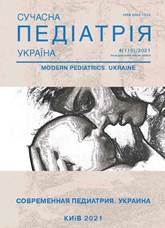Frequency of involvement different parts of the gastrointestinal tract in the pathological process in children with biliary dysfunction
DOI:
https://doi.org/10.15574/SP.2021.116.24Keywords:
children, biliary dysfunctionAbstract
The close anatomical and physiological connection of the digestive organs leads to a significant spread of functional disorders in various diseases.
Purpose — to investigate the frequency and features of the clinical course of biliary dysfunction (BD) in children.
Materials and methods. 66 children aged 10–18 years with BD were examined. The study included a complete clinical examination of children, laboratory and instrumental methods. To assess the severity of clinical symptoms in the examined patients was used traditional score scale of symptoms (0–3 points) and the frequency index (FI).
Results. In most children, the database was combined with other functional and organic lesions of the digestive tract (n=56, 84.8%). The database was most often combined with chronic gastritis and duodenitis, as well as with functional motor disorders. FI in children with BD involved in the pathological process of the stomach and duodenum was the highest (0.59), and IR in children with BD and intestinal involvement was the lowest (0.23). The relationship between the frequency of combined pathology and the frequency of cases of increase in the size of the gallbladder (χ2=22.87 at a critical value of χ2=9.33 for the significance level p<0.01). Hyper- or hypofunctions of the biliary tract occurred with the same frequency.
Conclusions. Biliary dysfunction in children is significantly more often combined with chronic gastritis and duodenitis, as well as with other functional disorders of the gastrointestinal tract (duodenogastric reflux). In children with biliary dysfunction and involvement in the pathological process of other parts of the gastrointestinal tract there is an increase in the frequency of exacerbations, more pronounced signs of dyspeptic syndrome on the background of pain with the same intensity and more often ultrasound reveals signs of gallbladder dysformation.
The research was carried out in accordance with the principles of the Helsinki declaration. The study protocol was approved by the Local Ethics Committee of all participating institution. The informed consent of the patient was obtained for conducting the studies.
No conflict of interest was declared by the authors.
References
Bates JA, Dinnan K, Sharp V. (2019). Biliary hyperkinesia, a new diagnosis or misunderstood pathophysiology of dyskinesia: A case report. Int J Surg Case Rep. 55: 80-83. https://doi.org/10.1016/j.ijscr.2019.01.011; PMid:30716707 PMCid:PMC6360460
Chen CH, Lin CL, Hsu CY, Kao CH. (2018). Association Between Type I and II Diabetes With Gallbladder Stone Disease. Front Endocrinol (Lausanne). 9: 720. https://doi.org/10.3389/fendo.2018.00720; PMid:30555418 PMCid:PMC6281708
Cullen JM, Stalker MJ. (2016). Liver and Biliary System. Jubb, Kennedy & Palmer's Pathology of Domestic Animals. 2: 258-352.e1. https://doi.org/10.1016/B978-0-7020-5318-4.00008-5; PMCid:PMC7149729
Di Serafino M, Gioioso M, Severino R et al. (2020). Ultrasound findings in paediatric cholestasis: how to image the patient and what to look for. J Ultrasound. 23 (1): 1-12. https://doi.org/10.1007/s40477-019-00362-9; PMid:30756259 PMCid:PMC7010886
Lin TK, Fishman DS, Giefer MJ et al. (2019). Functional Pancreatic Sphincter Dysfunction in Children: Recommendations for Diagnosis and Management. J Pediatr Gastroenterol Nutr. 69 (6): 704-709. https://doi.org/10.1097/MPG.0000000000002515; PMid:31567892 PMCid:PMC6878194
Loranskaya ID. (2013). Functional disorders of the biliary tract. M: Forte print: 92.
Ministry of Health of Ukraine. (2013). Order of the Ministry of Health of Ukraine No. 59 of January 29. Unified clinical protocols of medical care for children with diseases of the digestive system. Sovremennaya pedyatryya. 4: 20-31.
Norsa L, Nicastro E, Di Giorgio A, Lacaille F, D'Antiga L. (2018). Prevention and Treatment of Intestinal Failure-Associated Liver Disease in Children. Nutrients. 10 (6): 664. https://doi.org/10.3390/nu10060664; PMid:29882922 PMCid:PMC6024802
Sasahira N, Hamada T, Togawa O et al. (2016). Multicenter study of endoscopic preoperative biliary drainage for malignant distal biliary obstruction. World J Gastroenterol. 22 (14): 3793-3802. https://doi.org/10.3748/wjg.v22.i14.3793; PMid:27076764 PMCid:PMC4814742
Sebekina OV. (2011). Features of the course of urticaria in patients with Helicobacter-associated diseases of the upper digestive tract: Abstract dis. for scientific research. degree of Cand. honey. Sciences: spec. 01.14.04 «Internal Diseases». Moscow: 24.
Shanmugam H, Molina Molina E, Di Palo DM et al. (2020). Physical Activity Modulating Lipid Metabolism in Gallbladder Diseases. J Gastrointestin Liver Dis. 29 (1): 99-110. https://doi.org/10.15403/jgld-544; PMid:32176752 PMCid:PMC8114792
Simon DA, Friesen CA, Schurman JV, Colombo JM. (2020). Biliary Dyskinesia in Children and Adolescents: A Mini Review. FrontPediatr. 8: 122. Published 2020 Mar 24. https://doi.org/10.3389/fped.2020.00122; PMid:32266192 PMCid:PMC7105807
Wilkins T, Agabin E, Varghese J, Talukder A. (2017). Gallbladder Dysfunction: Cholecystitis, Choledocholithiasis, Cholangitis, and Biliary Dyskinesia.Prim Care. 44 (4): 575-597. https://doi.org/10.1016/j.pop.2017.07.002; PMid:29132521
YiD Y, ChangE J, Kim JY, Lee EH, Yang HR. (2016). Age, Predisposing Diseases, and Ultrasonographic Findings in Determining Clinical Outcome of Acute Acalculous Inflammatory Gallbladder Diseases in Children. J Korean Med Sci. 31 (10): 1617-1623. https://doi.org/10.3346/jkms.2016.31.10.1617; PMid:27550491 PMCid:PMC4999405
Downloads
Published
Issue
Section
License
Copyright (c) 2021 Modern Pediatrics. Ukraine

This work is licensed under a Creative Commons Attribution-NonCommercial 4.0 International License.
The policy of the Journal “MODERN PEDIATRICS. UKRAINE” is compatible with the vast majority of funders' of open access and self-archiving policies. The journal provides immediate open access route being convinced that everyone – not only scientists - can benefit from research results, and publishes articles exclusively under open access distribution, with a Creative Commons Attribution-Noncommercial 4.0 international license (СС BY-NC).
Authors transfer the copyright to the Journal “MODERN PEDIATRICS. UKRAINE” when the manuscript is accepted for publication. Authors declare that this manuscript has not been published nor is under simultaneous consideration for publication elsewhere. After publication, the articles become freely available on-line to the public.
Readers have the right to use, distribute, and reproduce articles in any medium, provided the articles and the journal are properly cited.
The use of published materials for commercial purposes is strongly prohibited.

